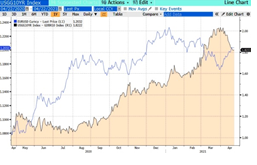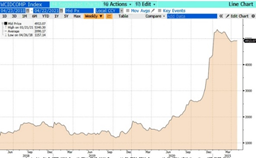Fixed income
Central banks’ balance sheet expansion was the main driving force behind the asset rally of the recent years. With an expected strong recovery after the Covid-19 triggered supply shock that halted the global economy for months, inflation back on the agenda sooner or later all CBs will have to deal with ending the era of literally endless liquidity on the markets and will have to find balance between protecting fragile markets and limiting inflation expectations.
Early December 2020 the US Treasury spot curve steepness showed a trend break after more than 6 years of flattening and presented an impressive 130 bp rise in the 2Y – 10Y spread within 3 months without any actual move from the FED. Such change in the curve however is not without historical examples.

The German benchmark curve is lagging this move by approximately 5 months, which helped the 10Y spread between the USD and EUR rates reach 200 bps (last seen in Feb 2020) and supported the dollar.

The new US government presented a recovery plan that is going to push the country’s deficit to historic levels (unseen since WWII). Governmental expenditure, focused mostly on energy and infrastructural investments, need funding of 2000 bln USD (over the whopping 1000bln + package already passed by legislature). Given the currently limited market appetite for longer dated fixed income assets we expect most of this new issuance to be bought by the FED itself. Since the FED introduced a de facto curve control, it is very likely to limit the secondary market effects of a jump in issuance levels (and let yields rise in a controlled manner).
Euro-zone economies are highly likely to present a similar economic plan soon: we expect the successor of Chancellor Merkel to be more forgiving in the aspect of governmental expenditure. Furthermore, the EZ needs to re-evaluate its role in global economy to recover from the losses of the Trump-era and the aftershocks of Brexit (not to mention the economic ties with China) as well as internal cohesion problems.
While the US presented a 4,3% annualized growth in GDP in Q4 2020 (full year GDP -3,5%) the EZ countries returned to negative figures (-0,7% in Q4 and -6,6% for 2020). The FED must face a headline CPI of 2,6% in its new framework that allows overshoots, giving it decent room to maneuver, the ECB has a strict (and asymmetrical) target of 2%, headline inflation at 1,3%.
In our opinion the ECB needs to end the NIRP (introduced in 2014), let yields rise moderately along with the new fiscal approach and recreate the monetary transmission channels as soon as possible. It wouldn’t be surprising at all if the ECB chose a similar approach to control the shape of the curve as the FED did.
After almost a decade of zero or sub-zero rates, deflation and strict fiscal policies the EZ (and the ECB) would need to redefine its goals to support a decent recovery and more economic integration to rebuild itself following the 2020 shock.
Equities
To put it in simple terms: it is extremely hard no to see an overblown bubble on the equity markets and not to expect any correction from these stellar P/E levels. Even with the current level of monetary support from all central banks, economies must face three major issues in the upcoming months:
- rising production costs due to higher labor cost and skyrocketing shipping costs
- shortage of raw materials
- shortage of semiconductors
These factors are expected to translate into higher consumer prices and higher inflation in the coming months. Higher inflation (both perceived and expected) usually translates into higher rates, and even the most supportive central bank monetary policies and direct market operations would not postpone these effects for long.
The “V-shaped” recovery expectations might fit the US, but surely will not apply to the EU. While vaccination is going well overseas, we are facing the third wave of lockdowns in Europe. Consumer spending in the US is supported by stimulus (lifting the consumer staples sector) investments are driven by governmental spending (utilities and healthcare sector). Fast vaccine rollout helps the US to open its economy sooner, creates more jobs and gradually pushes hourly wages higher.
Meanwhile, the Euro-zone itself is facing a political challenge as Germany is about to withdraw its support from the European Recovery Fund based on the ruling of the German Constitutional Court. Apart from the third wave of lockdown and the problems with the pace of vaccination, political headwinds are going to pose threat to the EU recovery.
Sentiment indicators have improved significantly, order books are getting filled on both sides of the Atlantic, but given the factors detailed above, we expect much stronger and faster recovery in the US than in the EU.
Higher labor and shipping costs are going to appear in consumer prices soon and that will eventually lead to some kind of central bank response. We expect the FED to address this issue much sooner, but with much cautiousness, to minimalize the effect of rising yields on the equity markets. Fast recovery in the US will support stocks, thus we expect all equity markets to perform well in the coming quarter, however we see limited space for a massive equity rally, but rather expect sector rotation with energy, finance and technology sectors outperforming others.
If (and that is a strong if) political issues are solved in the EU and the Recovery Fund gets green light, we expect the EU economies to follow suit, but GDP figures are expected to show much smaller turnaround from the current (negative) trends in Europe. If Chancellor Merkel’s successor fails to drive the zone out of this political debate, we expect the ECB to face rising global inflation with near zero growth in the second quarter.
Commodities
The widely anticipated commodity supercycle is postponed – for now at least. Global recovery might be a bit slower than expected earlier, and the returning strength of the USD is not helping the raw material prices either. Nevertheless, certain issues will keep commodity prices elevated for a prolonged period.
Logistics and shipping met little to no demand as the global economy came to a halt during the first wave of Covid-19. Many cargo ships and containers were sold or scrapped last year. The recovery in global trade came faster and stronger than expected pushing container prices. The WCI (World Container Index) mapping the price of a standard 40-foot container quadrupled within a year (currently at around 5000 USD) showing massive disruptions.

Spike in demand for durable and semi-durable goods also caused shortages in semi-conductors. Computer chip shortages are a result of rising production costs, lack of production capacity and the protectionist economic policies of the suppliers of raw materials (like rare-earth elements).
Covid-related supply disruptions also caused shortages in other areas, pushing base metal prices much higher despite the softer than expected overall demand.
Although we expect economic recovery to gather pace in Q2, upside in non-energy raw material prices might be limited as global trade capacity is gradually returning to normal, but we see very limited chances of a significant downside correction.
Disclaimer:
This material has been prepared as a document for information and illustrative purposes only. It is not, and should not be considered as “investment advice” or as a “recommendation” regarding a course of action to buy or sell any financial instruments, or to make any investment decision. The whole content of this document reflects the author(s) personal views only, which may influence decisions made by Primus Trust Corp. when investing its own assets, but cannot be generally considered as Primus Trust Corp.’s view. The content of this document is not a market research, or investment analysis of any kind.

